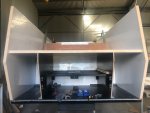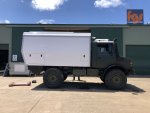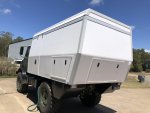U1300L camper build in Australia
The goal for this camper is a setup for two, toilet and shower inside, dinette, access to kitchen from inside or outside. Highly insulated against heat & cold, low roof height when travelling and a total vehicle weight, when loaded, of 6.5 metric ton. Minimal electronics and finicky things that will break while remote. Everything to be robust and Mog-worthy.
We looked at keeping and cutting the existing subframe and decided against it. We wanted a subframe that incorporated the slide out side stairs, the spare wheel assembly and the large toolboxes. We are also weight conscious so want a subframe that is sufficiently strong to carry the much lighter camper box. It was cheaper and better to build a new one rather than hack the existing one. This also allows us to sell the Binz box complete.
The finalized subframe was sandblasted, zinked and powder coated and weighed in at 269.5kgs.
The goal for this camper is a setup for two, toilet and shower inside, dinette, access to kitchen from inside or outside. Highly insulated against heat & cold, low roof height when travelling and a total vehicle weight, when loaded, of 6.5 metric ton. Minimal electronics and finicky things that will break while remote. Everything to be robust and Mog-worthy.
We looked at keeping and cutting the existing subframe and decided against it. We wanted a subframe that incorporated the slide out side stairs, the spare wheel assembly and the large toolboxes. We are also weight conscious so want a subframe that is sufficiently strong to carry the much lighter camper box. It was cheaper and better to build a new one rather than hack the existing one. This also allows us to sell the Binz box complete.
The finalized subframe was sandblasted, zinked and powder coated and weighed in at 269.5kgs.

















